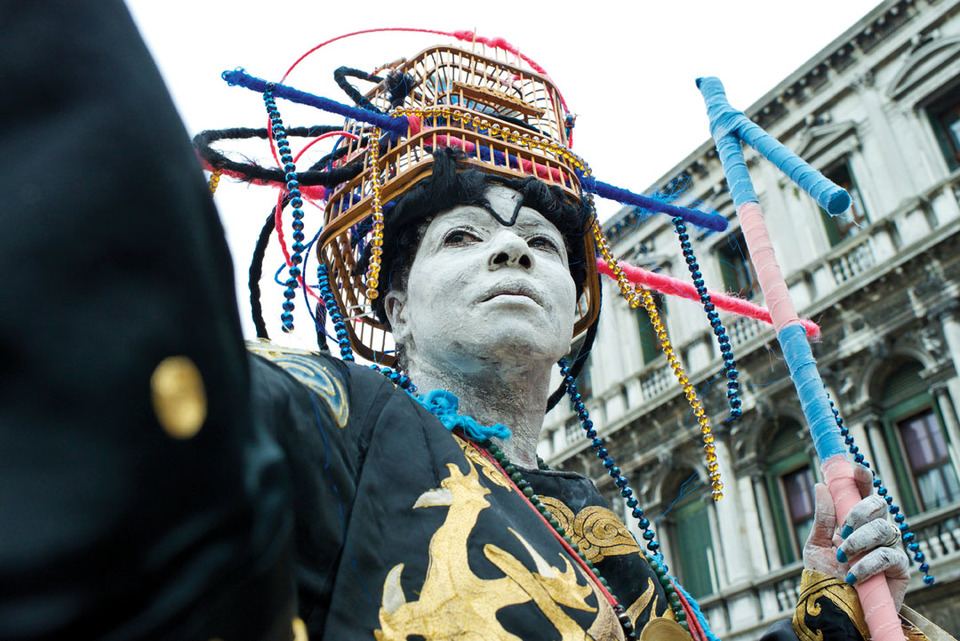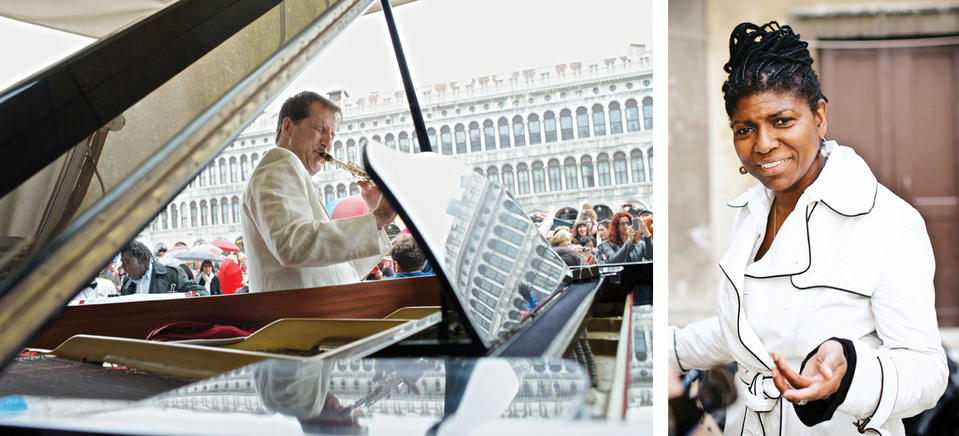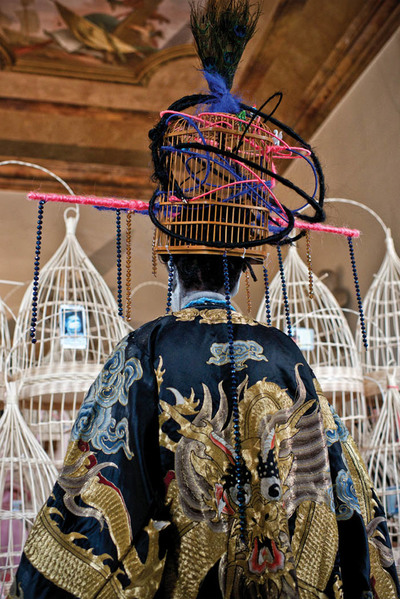Life in Venice

VENICE, ITALY—She walked out of the five star Hotel Bauer in a Chinese emperor’s robe, made up in whiteface, and wearing a huge contraption on her head. It looked like a giant birdcage and had a peacock feather attached. Surrounded by dancers and musicians, she then slowly, majestically, walked through the heart of St. Mark’s Square, one of the world’s iconic assemblages of art and architecture, and into the Museo Archeologico.
This performance by Cuban-born Maria Magdalena Campos-Pons, who lives and works in the Boston area and teaches at the School of the Museum of Fine Arts, was part of the opening of this year’s Venice Biennale. It was also completely illegal. She’d applied for a permit, but unless you’re, say, the Pope, you don’t get a permit easily in Venice. Such is Italian, and particularly Venetian, bureaucracy.
Campos-Pons is the first U.S. resident to be invited to show in the Cuban quarters of the world’s most important and oldest biennial. She’d exhibited in the Biennale once before, in 2001, as part of a group show on African art. She loves Cuba, praises its cultural heritage, and can now travel there freely thanks to eased travel restrictions. She showed in last year’s Havana Biennial, but as an international artist, not representing the U.S. The trend in biennials now, worldwide, is to put on what the curators feel is the best art, no matter where the artists are from.
In Venice this year, the country of Cuba, which doesn’t have one of the long-established national pavilions in the Giardini, has rented part of the archeology museum and invited 14 artists to participate, including Campos-Pons and her husband, Neil Leonard, a musician, professor at Berklee College of Music in Boston, and authority on Cuban music. Together, they orchestrated not just the one-time-only “guerrilla performance,” as Leonard calls it, which included Cuban musicians they’d imported, the Los Hermanos Arango group, but also an exhibition in the museum, up for the duration of the Biennale. They’d brought several students to Venice, to help with the large-scale project and also to learn that such endeavors aren’t the work of just one or two artists. It takes a team. Their team members were Museum School students Marjorie Almstead, Toshiki Yashiro, Chelsea Coon, Kyung-hee Kim, and Berklee student Jackson Lim.
After her permit to perform in St. Mark’s Square clearly was not going to be issued, Campos-Pons approached the Café Florian, in the heart of St. Mark’s, a gathering place that dates back to 1720. Here she had more success. Florian evacuated its own musicians from its prominently located tented quarters in the square so that Campos-Pons’s Cubans could play there. While the musicians played, one of Campos-Pons’s students distracted the police. Amazingly, all went well. After the fact, the artist said that Florian’s waiters could be heard chanting Cuban music.
The startling performance in St. Mark’s drew already committed fans who had gathered at the Bauer for a prosecco reception hosted by Campos-Pons’s New York dealer, the Stephan Stoyanov Gallery. These were people who had some inkling of what was going on and joined the procession to the square, which, along the way, gathered some of the tourists who chronically clog St. Mark’s. Stoyanov admitted to being in a cold sweat about the illegality of the performance, while he is a staunch supporter of Campos-Pons’s work. She says of him, “He has been truly wonderful. He’s very committed, somebody who listens. He’s made introductions to people who are very important. It’s not about being with the biggest gallery. It’s about the quality of communication.…There is some kind of work that is hard to sell, but there is a buyer for everything. Richard Serra is difficult to sell, too. Anish Kapoor is difficult to sell.” Campos-Pons quickly qualifies that she doesn’t necessarily group herself with those two stars. She doesn’t live for sales, and frankly explains, “I need to send my kid to college and pay my bills.”
Campos-Pons shows in galleries from Miami to Milan, and while she was in Venice her Milanese dealer, Gallery Pack, paid for her large apartment in a palazzo on the Grand Canal. She hasn’t had a Boston gallery for years, although she is still on the Howard Yezerski website. “I respect him,” she says, “but I am ambitious. I work very hard. There are things I aspire to, and I didn’t see what keeping the gallery would do for me. You’re in a gallery for what you can’t do for yourself.” Other than her galleries’ contributions and the space provided by Cuba, though, she had to do her own fundraising for her Venice appearance, with help from several philanthropic Bostonians. She herself covered most of the living expenses of the students who accompanied her.

Top: Maria Magdalena Campos-Pons, performance, Biennale of Venice 2013, Cuban Pavillion, San Marco, Venice, Italy. Photo: Riccardo Gay, lugermad. Courtesy of Magdalena Campos-Pons Galleries. Above left: Neil Leonard; above right: Maria Magdalena Campos-Pons, both at the Biennale of Venice 2013, Cuban Pavillion, San Marco, Venice, Italy. Photos: Riccardo Gay, lugermad. Courtesy of Magdalena Campos-Pons Galleries.
Campos-Pons was disappointed that no one from the Museum School came to cheer her on at her opening. “I am the only artist based in Boston to show in the Venice Biennale,” she says. “I don’t know what that means to Bostonians. I would have loved to have people from the School here. Yesterday, the Guggenheim was here, along with MoMA, the New Museum, and curators from all over the world. It was a dream come true for me. But I would have loved to have some of my colleagues here for the opening.” Boston museums, she thought, might have a later presence and their patrons a chance to see her work.
Campos-Pons’s show in the archeology museum is entitled 53 + 1 =54 + 1 =55, Letra del ano. The numbers refer to the artist’s age, the number of years since the Cuban revolution, and the 55th Venice Biennale. As is her practice, autobiography, politics and a sense of place inform the piece. At the opening, Museum School students handed out tiny vials of Venetian water, another souvenir of a strange land. “Drink at your peril” seemed to be the message.
Campos-Pons’s unsettling work inhabits a room that could hardly be further from a white-walled gallery. Installation was a challenge, because of height limitations and a prohibition on scaffolding. So she and her crew used a ladder. The room is otherwise occupied by Roman busts, all male, except for one of Antonia, the mother of the Emperor Claudius. They line the walls, looking rather forbiddingly at what is going on in the center of the room: stacks of more wicker birdcages containing unraveling bits of blue or pink fabric and videos either of Campos-Pons herself, again in whiteface and disgorging rolls of fabric from her mouth, or those of ordinary folks on the street in Cuba. The Cubans were asked about family members who had left the country. They were also asked about what they wanted from America, says Leonard. “One guy was a barber and wanted a razor, so we went to Harvard Square and bought him a $120 razor.”
Even if you understand Spanish as spoken in Havana, though, the conflicting tapes are cacophonous, meant to convey the sound of life in Cuba. “It was supposed to be like a conference among caged birds chattering to each other,” Leonard says. “In Cuban houses,” Campos-Pons adds, “you walk by and the doors are open and you see all the way through the house, the bedroom, the living room, there’s no privacy. There are iron grates on the windows, but no glass because it’s expensive. You hear everything, all your neighbors.”
Above: Maria Magdalena Campos-Pons, performance, Biennale of Venice 2013, Cuban Pavillion, San Marco, Venice, Italy. Photo: Riccardo Gay, lugermad. Courtesy of Magdalena Campos-Pons Galleries.
The birdcages symbolize both captivity and freedom. Cages can both be traps and protection from the outside world. The Venice piece also alludes to Campos-Pons’s Yoruba ancestry. The crusty whiteface she wore at the performance and in the videos, which made her look like a corpse rising from the dead, is traditional among the Yoruba, the Nigerian people from whom she is descended. It’s a sign of cleansing and reaching a spiritual height, Campos-Pons says. The pink and blue of the fabric are the colors of this year’s Yoruba flag, the hues chosen by priests in a conclave. Although she lectures on art and spirituality, she does not profess to be an initiate in the Yoruba ways. She is quick to add, “I use Yoruba tradition as an artist.” Similarly, Leonard says, the Cuban musicians who performed with Campos-Pons have a limit to what ritualistic music they can perform. He calls what they do the purest manifestation of African culture in the Americas. The Chinese robe Campos-Pons wore at the performance, meanwhile, found in an antique store in Boston, alludes to the Chinese blood inherited through her mother. (She once created a work called My Mother Told Me I Am Chinese.) Of her Venice piece, she says, “I was trying to mix all the cultures I am from.”
Sitting on a sofa in her palazzo digs after her opening, Campos-Pons was toying with rose petals that had dropped from bushes in the garden. She folded each one into a tiny symmetrical shape. Her hands couldn’t stay still. It seems certain those Venetian petals will inspire some extraordinary and transfixing future work.
Christine Temin was the art and dance critic at the Boston Globe for over two decades and now writes for a variety of international publications. She has taught at Middlebury College, Wellesley College, and Harvard University. She is author of Behind the Scenes at the Boston Ballet.

